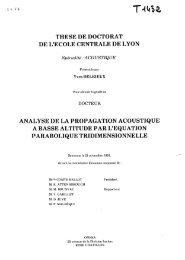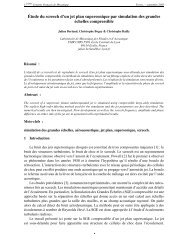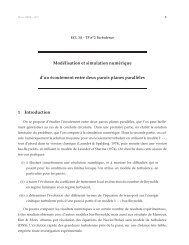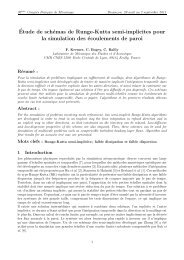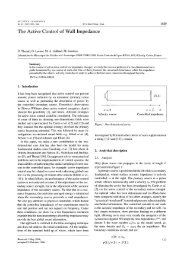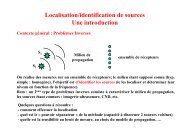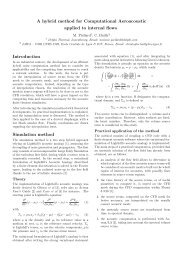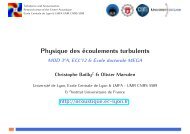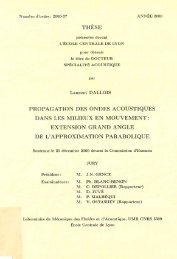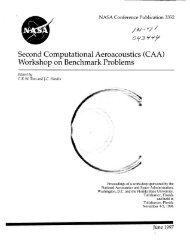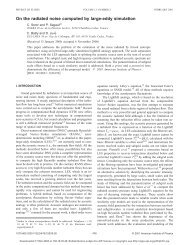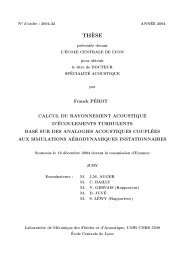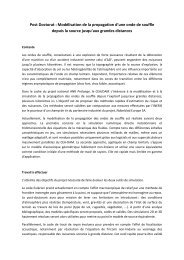ERCOFTAC Bulletin - Centre Acoustique
ERCOFTAC Bulletin - Centre Acoustique
ERCOFTAC Bulletin - Centre Acoustique
Create successful ePaper yourself
Turn your PDF publications into a flip-book with our unique Google optimized e-Paper software.
were performed at the same cluster, which showed<br />
a 8 times better performance for both solvers. This<br />
is probably due to load changes on the system. The<br />
tests furthermore showed, that the overall performance<br />
for this particular test case is at its optimum between<br />
4 and 8 NoisSol processes coupled to 4 PIANO processes.<br />
Currently under examination is a sudden instability<br />
in the near field, which occurred after<br />
tsim ≈ 9.0 ≈ 260000 dt for pure NoisSol and<br />
≈ 4.6 ≈ 135000 dt for PIANO+. Due to the long<br />
period of successful computation this is probably related<br />
to a strong, source triggered disturbance.<br />
Figure 3: Sound pressure level, NoisSol, PIANO+ and<br />
Lockhard [5]<br />
Figure 4: Pressure field, uncoupled computation, t=2.0<br />
5 Conclusion<br />
The presented DG scheme was applied to the<br />
NASA 30P30N airfoil noise test case as stand-alone<br />
solver and in a coupled framework. The results are very<br />
encouraging from the qualitative and quantitative point<br />
of view and proved the operability of the scheme. To<br />
improve the applicability a reliable examination of the<br />
performance behavior of the coupled scheme for different<br />
Figure 5: Pressure field, coupled computation, t=2.0<br />
Uncoupled Coupled<br />
Code NoisSol NoisSol<br />
nDegF r 0.747e6 0.28e6<br />
dx 0.002 . . . 0.2 0.002 . . . 0.01<br />
tsim 9.03 4.61<br />
tCP U 1840 1370<br />
tCP U/ 27.3e-5 106e-5<br />
(nDegF r · tsim)<br />
Coupled<br />
Code PIANO Combined<br />
nDegF r 6.57e6 6.85e6<br />
dx 0.004<br />
tsim 4.61 4.61<br />
tCP U 1370 2750<br />
tCP U/ 4.53e-5 8.70e-5<br />
(nDegF r · tsim)<br />
Table 2: Computation times<br />
CPU distributions and in comparison to the uncoupled<br />
scheme is necessary.<br />
Acknowledgement<br />
This work has been done with the kind support of the<br />
Institute of Aerodynamics and Flow Technology (IAS)<br />
at the German Aerospace Center (DLR), in particular<br />
Professor Jan Delfs and Dr. Roland Ewert, who delivered<br />
the acoustic sources for the calculations and made their<br />
PIANO code available for the coupling framwork.<br />
References<br />
[1] M. Dumbser: Arbitrary High Order Schemes for the<br />
Solution of Hyperbolic Conservation Laws in Complex<br />
Domains. PhD thesis, Universität Stuttgart<br />
(2005)<br />
[2] G. J. Gassner, F. Lörcher, C.-D. Munz and J. S. Hesthaven:<br />
Polymorphic nodal elements and their application<br />
in discontinuous Galerkin methods. JCP<br />
228, Issue 5 (2009)<br />
[3] F. Lörcher, G. Gassner and C.-D. Munz: Arbitrary<br />
High Order Accurate Time Integration Schemes for<br />
Linear Problems. ECCOMAS CFD (2006)<br />
[4] D. P. Lockard and M. M. Choudhari: Noise Radiation<br />
from a Leading-Edge Slat. AIAA paper 2009-<br />
3101 (2009)<br />
32 <strong>ERCOFTAC</strong> <strong>Bulletin</strong> 90



